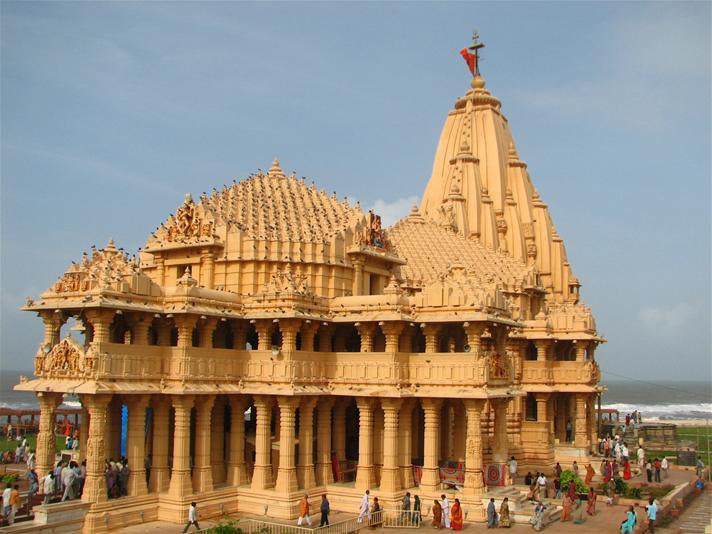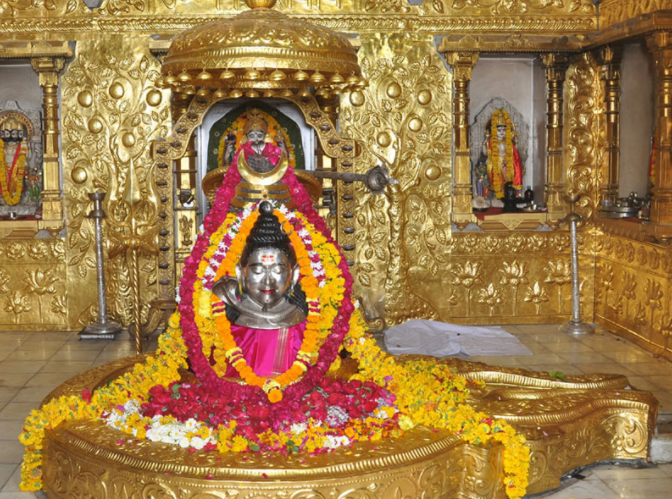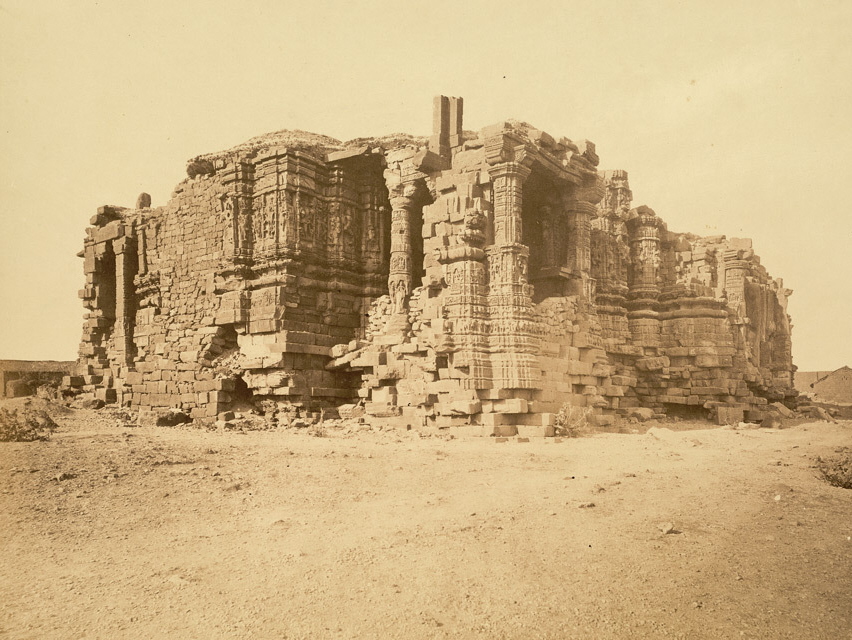During the period of 7th century BC, a magnificent temple was being constructed, all in pure gold and jewels. Little did the Maitraka kings of Vallabhi know this superlative creation of theirs would see destruction and renovations seven times in a row.
Present day Somnath Temple, in full glory Photo courtesy : Wikimedia Commons
Legends say, the temple was originally created by Chandra, the Moon God himself. Chandra had married all twenty seven daughters of Daksha. However, his inclinations lay solely on the youngest one, Rohini. He showered all importance on her while the other Daksha kanyas grew increasingly lonely and indignant. Upset, Daksha cursed him, and almost immediately he became lightless. As a result the whole world became dark. The Gods were in a fix, and they decided to pursuade Daksha to forgive Chandra. After a lot of request from the gods Daksha advised Chandra to start worshiping Lord Shiva, because His blessings alone could cede his radiance back. Chandra immediately reached the region of Prabhas and started his sacrament. In the night of Aridra Nakshatra, impressed with the Moon God’s penance, Lord Shiva manifested himself in the Somnath Jyotirlingam and blessed him by modifying the curse to only periodic waning each year. Regaining his brilliance, the Moon God erected the Somnath temple dedicated to Lord Shiva, and perhaps this is how Lord Shiva got the name of Sommeshwar. It is believed that even today on moonless nights Chandra comes to take a dip in the holy waters of the sea there and begins to shine again.
The Lingam Photo courtesy: www.thedivineindia.com
Located in Prabhas Kshetra near Veraval, Somnath Mandir falls in Saurashtra region that lies on the western coast of Gujarat. Built in the style of Chalukyan architecture, the Somnath temple stands 155 feet tall, approximately seven storeys high. The architectural beauty of Somnath Temple essentially mirrors the masonry skills of Sampuras: Gujarat’s master masons. Breathtaking stone carvings and sculptures adorn the walls, inside out. In 1024, the temple faced its first raid by Mahmud of Ghazni, who looted camel-loads of jewels and valuables. With time, the Paramara King Bhoj of Malwa and the Solanki King Bhima of Gujarat took the initiative to rebuild the temple during 1026-1042 approximately. By the temple’s fifth reconstruction, the wooden structure was replaced with a stone structure. Couple of centuries of peace later, the temple was mercilessly destroyed in 1297 by the Sultanate of Delhi, and yet again in 1394. Emperor Aurangzeb’s attack in 1706 was the last blow. What remains now seems to be only a shadow of what this great architectural genius may have been. However, invasions like these may have stripped the temple off its wealth, but its piety continues to remain unscathed.
In ruins: What the temple had become Photo courtesy: Wikimedia Commons
At present, the temple got renovated by the Shree Somnath Trust in 1995 in the company of the Government of India, and is under the maintenance of the Trust. This is when our Dr. Rajendra Prasad’s words ring true:
“Somnath Temple signifies that the power of creation is always greater than the power of destruction.”
Temple tips:
- The temple opens at 6:00 am every day, and is left open for the entire day until 9:00 pm.
- Aartis happen thrice a day: 7:00 am in the morning, 12:00 pm at noon and 7:00 pm in the evening.
- Cameras and mobiles are not allowed inside.
- At about 8:00 pm, a light and sound show is conducted, which delivers the history and significance of the temple.
- The nearest airport is in Daman & Diu, which is almost 100 kms from the Somnath beach.
- The nearest railway station is the Veraval station.
- Best time to visit is the month of October as the climate remains cool and breezy. Month of August may be slightly overwhelming for tourists because of overcrowding.
- there are ample lodging and dining facilities around, affordable and clean.
- An additional benefit that the temple provides is their own bus service called the “Somnath Tirth Darshan”, at very reasonable rates, that enables the visitors to see the major temples around along with some local sightseeing.




